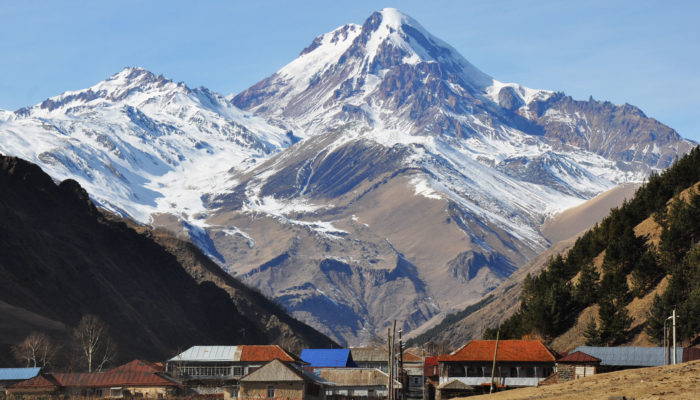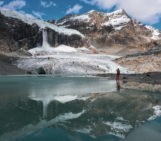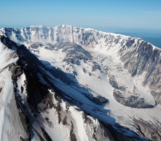
The Caucasus is one of the most studied glacierized regions in the world (see previous Cryoblogs on Caucasus glaciers here and here). In this week’s blog, Levan Tielidze tells us about the health of the Greater Caucasus glaciers. His first study published this year indicates that the rate of decline in glacier extent between 2000 and 2020 in the Greater Caucasus is four times higher than it was between 1911 and 1960 and three times higher than it was between 1960 and 1986. Meanwhile, his second study shows that the mass loss of all the glaciers in the Greater Caucasus over the past 20 years amounted to 11 billion tonnes of water!

Figure 1. An example of a century-long area change of Tsaneri Glacier from 1890 (upper) to 2020 (Sentinel 2B) (lower). At the end of the 19th century, Tsaneri was the second largest glacier in Georgia with a total surface area of ~48 km². It’s area has since decreased to 33 km2 as measured in ~2020. i.e. Tasneri Glacier has shrunk by 31% over that time period! Photo credit: Tielidze et al., 2022
How did we figure out the health of the Greater Caucasus glaciers?
For the first study, we used medium-resolution Landsat and Sentinel images from 2000 and 2020. We also used high-resolution SPOT images from 2019, and the ASTER Digital Elevation Model (DEM) from 2011 over our study area. The satellite images were used to make an assessment of glacier area and the DEM was then used to determine aspect, slope and elevation, for all glaciers.
For the second study we analyzed regional changes in surface elevation (or thickness) and geodetic mass balance for all Greater Caucasus glaciers between 2000 and 2019 based on a recently published dataset.
Glacier area change over 2000-2020
Within the entire Greater Caucasus, the total glacierized area mapped for 2000 and 2020 was 1382 km² and 1061 km², respectively, resulting in 23 % or 320 km² reduction in total glacier area over the last twenty years. To give you a better idea, this is about the size of the Republic of Malta. The rates of area shrinkage vary between the northern and southern and between the western, central, and eastern Greater Caucasus. Area shrinkage is significantly stronger in the eastern and western Greater Caucasus, where most glaciers are very small (Figure 2).

Figure 2. Changes in glacierized area of western Greater Caucasus in 2000 (green outlines) (Landsat 5 image) and 2020 (yellow outlines) (Sentinel 2 image). Figure credit: Levan Tielidze
Glacier mass change over 2000-2019
Our main study results indicate a mean regional glacier mass balance (net change in glacier total mass) change in 2000–2019 (Figure 3). We calculated that the net loss in the mass of all glaciers in the Greater Caucasus over the past 20 years amounted to the 11 Gt (gigatonne) of water. This represents about 448,000 Olympic-size swimming pools. We measured strong acceleration in mass loss and the thinning rates since 2010. The observed decrease in mean annual mass balance is higher on debris-covered glaciers than those on debris-free glaciers (Figure 4) between 2000 and 2019.

Figure 3. Mean annual geodetic mass balance (m w.e. a−1) and cumulative mass balance (m w.e.) for all Greater Caucasus glaciers in 2000–2019. Figure Credit: Tielidze et al., 2022

Figure 4. A comparison of debris-free Tbilisa Glacier (upper photo) and debris-covered Buba Glacier (lower photo) in the Georgian Caucasus. Photo Credit: Levan Tielidze
Glacier melting relative to local climate change
Accelerated glacier melting over the last two decades in the Greater Caucasus may be explained by a sustained increase in summer temperatures and a decrease in winter precipitation associated with regional global warming. The average summer temperature in the mountainous region of the Greater Caucasus has increased by 0.6°C over 2000-2020. In parallel with the increased summer temperatures, an extension of the melting period was observed on both slopes of the Greater Caucasus. Snow-ice-covered areas of the Greater Caucasus are subject to dust outbreak events originating from desert regions able to significantly decrease snow albedo. Several dust depositions events that originated from the Sahara between 2009 and 2018 period were also considered one of the significant indicators for glacier thinning in this region.
Meltwater from glaciers and surface snow represents an important water source for communities, ecosystems, and electricity generation in the Greater Caucasus. The presence of these glaciers also has a positive impact on the economy as a result of them being a major tourist attraction in this region (cover figure). Several national parks in the Greater Caucasus welcome thousands of visitors each year. On the other hand, glacier hazards such as ice-rock avalanches, glacier surging, glacier lake outburst floods, are relatively common in this region, leading to major casualties. Thus, estimation of glacier change is of great significance and close monitoring of the glaciers should continue in this part of the world. This will also provide important information for future research on various socio-economic impacts such as water resource management, risk assessments, and tourism for the Greater Caucasus mountain region.
Further reading
- Tielidze, L. G., Nosenko, G. A., Khromova, T. E., and Paul, F. (2022). Strong acceleration of glacier area loss in the Greater Caucasus between 2000 and 2020, The Cryosphere, 16, 489–504
- Tielidze, L. G., Jomelli, V., and Nosenko, G. A. (2022). Analysis of Regional Changes in Geodetic Mass Balance for All Caucasus Glaciers over the Past Two Decades. Atmosphere, 13, 256
- Hugonnet, R., McNabb, R., Berthier, E., Menounos, B., Nuth, C., Girod, L., Farinotti, D., Huss, M., Dussaillant, I., Brun, F., and Kääb, A. (2021). Accelerated global glacier mass loss in the early twenty-first century. Nature 592, 726–731
- Previous Cryoblogs on the Greater Caucasus:
Edited by Marie Cavitte
 Levan Tielidze is a PhD student at the Antarctic Research Centre and School of Geography, Environmental and Earth Sciences, Victoria University of Wellington. His field of research is modern glaciers and glacial-geomorphological studies of the mountainous areas in the Late Quaternary.
Levan Tielidze is a PhD student at the Antarctic Research Centre and School of Geography, Environmental and Earth Sciences, Victoria University of Wellington. His field of research is modern glaciers and glacial-geomorphological studies of the mountainous areas in the Late Quaternary.
Contact email: tielidzelevan@gmail.com. Twitter: @LevanTielidze



